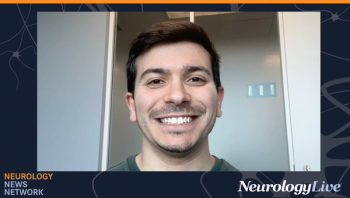
Headache, Dysarthria, and Right Hemiplegia in a Patient With Scleroderma
A 39-year-old male with a past medical history of hypertension and depression woke up with a severe headache, difficulty speaking, and right-sided weakness. Read the case details here.
Clinical case
A 39-year-old male* with scleroderma awoke with severe headache, difficulty speaking, and right-sided weakness. When he didn’t improve after several hours, his wife brought him to the emergency department.
Past medical history included hypertension and depression. The patient had not been prescribed immunotherapy for scleroderma. He was generally adherent to his medications (escitalopram, lisinopril, and nifedipine), but ran out last month. He quit smoking 10 years ago when he was diagnosed with scleroderma. He is married, doesn’t drink alcohol, and has no children. He is on disability for peripheral vascular disease. Family history is remarkable for rheumatoid arthritis in his mother and hypothyroidism in his maternal aunt. He acknowledged episodes of Raynaud’s phenomenon in winter.
On examination, vital signs were blood pressure 234/171, pulse 87, respirations 16, and temperature 99 degrees Fahrenheit. Medical exam revealed hard and tight skin around the nose and mouth (microstomia). On neurological examination, he had normal mental status; right-sided facial droop; dysarthria; 3/5 weakness in the right hand, arm, and leg; increased reflexes on the right with a Babinski sign; normal sensation; and slow finger to nose on the right without dysmetria. Initial National Institutes of Health (NIH) stroke score was 8 (2 for facial paralysis, 2 for right arm weakness, 2 for right leg weakness, 2 for severe dysarthria).
Laboratories
Complete blood count, chemistry panel, liver function tests, prothrombin time, and partial thromboplastin time were normal. Chest x-ray revealed an enlarged heart and mild to moderate pulmonary edema. A transthoracic cardiac echo demonstrated concentric left ventricular hypertrophy without thrombus.
Neuroimaging
Computed tomographic (CT) brain scan revealed an acute left basal ganglia hemorrhage (Figure 2). A large hypodensity in the right basal ganglia, suggestive of a subacute or remote ischemic stroke is also present (Figure 2). Computed tomographic angiogram (CTA) of the head demonstrated normal blood vessels. CTA of the neck revealed “atheromatous plaque with mild aneurysmal dilatation of the mid-cervical left internal carotid artery without high grade stenosis or obstruction.”
Hospital course
The patient’s hypertension was lowered with intravenous nicardipine. Blood pressure was stabilized with oral amlodipine, carvedilol, and lisinopril. Headache disappeared once blood pressure normalized.
A brain MRI was cancelled because the patient had a femoral artery stent incompatible with the MRI magnet. The stent had been placed 2 years prior for peripheral vascular disease.
The patient’s atheromatous plaque and aneurysmal dilatation of the left internal carotid artery were most likely related to chronic hypertension. Vascular surgery was consulted to consider stenting but recommended medical management.
Dysarthria and right hemiplegia improved by the second hospital day with an NIH score of 4 (1 for facial paralysis, 1 for right arm weakness, 1 for right leg weakness and 1 for mild dysarthria). Pulmonary edema resolved. He participated in physical and occupational therapy and returned home.
Discussion
Scleroderma is a rare, chronic autoimmune disease that causes fibrosis in multiple body systems. It affects more than half a million people in the United States. As is typical of autoimmune disorders, it is more common in women than men. It usually affects young adults but can also occur in children and the elderly. The etiology is unknown. Scleroderma can be broadly divided into two types; systemic sclerosis and a less severe form, localized scleroderma. Systemic sclerosis has the
Systemic sclerosis can affect both the central nervous system (CNS) and the peripheral nervous system (PNS). According to one comprehensive
The name scleroderma comes from its scarring effect on skin, but scleroderma also affects circulatory, digestive, and immune systems as well as joints, kidneys, lungs, and muscles. Cutaneous and parenchymal fibrosis, microvascular occlusive disease with vasospasm and intimal proliferation occurs, as well as increased
An epidemiologic study of 1238 patients with systemic sclerosis compared with 12,380 controls revealed that systemic sclerosis was associated with an 43% increased risk of new onset ischemic stroke and constitutes an independent risk factor for ischemic stroke.3 In another large population study, patients with systemic sclerosis had increased relative risk (RR) of myocardial infarction (RR 1.80), stroke (RR 2.61) and peripheral vascular disease (RR 4.35).1
Pathophysiology includes damaged vascular endothelial cells, perivascular inflammatory cell infiltrates, intimal thickening and vessel narrowing. Small arteries become fibrotic, less elastic, and prone to thrombosis. Dysregulated angiogenesis also occurs.2
This patient’s uncontrolled hypertension was the most likely etiology for both his current intracerebral hemorrhage (Figure 1) and prior ischemic stroke (Figure 2). The prior ischemic stroke had not produced clinical symptoms. Such “silent strokes” are not uncommon.4 Concentric left ventricular hypertrophy on the echocardiogram suggests longstanding hypertension. Accelerated atherosclerosis due to systemic sclerosis may have contributed to the ischemic stroke. Poor adherence with antihypertensive therapy likely triggered the hypertensive crisis associated with his acute hemorrhagic stroke.
Systemic sclerosis is a rare and challenging disorder to manage. Many neurologic complications can occur, including cerebral hemorrhage and ischemic stroke. In addition to improved medication adherence, this patient requires close follow up for hypertension management and secondary stroke prevention. Immune therapy for systemic sclerosis may need to be considered.
Take home messages
1. Systemic sclerosis is an independent stroke risk factor
2. Central and peripheral nervous system complications commonly occur in systemic sclerosis
3. Uncontrolled hypertension is a major risk factor for ischemic and hemorrhagic stroke
4. Ischemic and hemorrhagic stroke may co-occur
For more information, see: SIF (
*Details of this case were significantly changed to protect patient confidentiality.
References:
1. Man A, Zhu Y, Zhang Y, et al.
2. Amaral TN, Peres FA, Lapa AT et al.
3. Chiang CH, Liu CJ, Huang CC et al.
4. Seshadri S, Wolf PA. Modifiable risk factors and determinants of stroke. In: Grotta JC, Albers GW, Kasner E, et al. Stroke, Pathophysiology, Diagnosis, and Management, 6th Edition. 2016; Elsevier, Inc.
Newsletter
Keep your finger on the pulse of neurology—subscribe to NeurologyLive for expert interviews, new data, and breakthrough treatment updates.



























